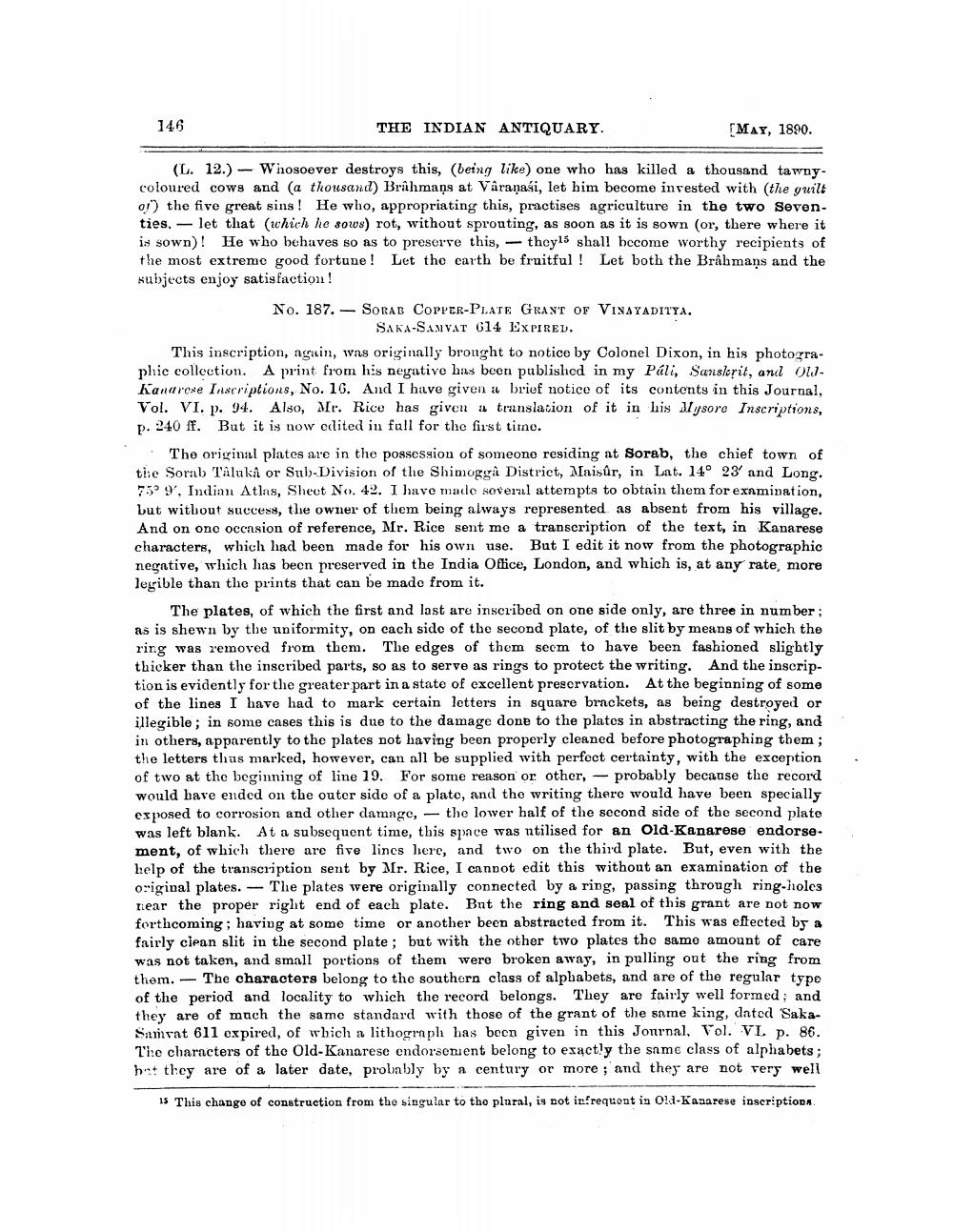________________
146
THE INDIAN ANTIQUARY.
[MAY, 1890.
(L. 12.) - Whosoever destroys this, (being like one who has killed a thousand tawnycoloured cows and a thousand) Brahmaņs at Varanasi, let him become invested with the guilt 0!') the five great sins! He who, appropriating this, practises agriculture in the two Seventies, — let that which he sows) rot, without sprouting, as soon as it is sown (or, there where it is sown)! He who behaves so as to preserve this, they15 shall become worthy recipients of the most extreme good fortune! Let the earth be fruitful! Let both the Brahmans and the subjects enjoy satisfaction!
No. 187. - SORAB COPPER-PLATE GRANT OF VINAYADITYA.
SAKA-SANAT 614 EXPIRED. This inscription, again, was originally brought to notice by Colonel Dixon, in his photographic collection. A print from his negative has been published in my Páli, Sanslerit, anil OWKanarose Inscriptions, No. 16. And I have given a brief notice of its contents in this Journal, Vol. VI. p. 94. Also, Mr. Rice has given a translation of it in his tysore Inscriptions, p. 240 ff. But it is now edited in full for the first timno.
The original plates are in the possession of someone residing at Sorab, the chief town of tiie Sorab Taluka or Sub-Division of the Shimogga District, Maisûr, in Lat. 14° 23' and Long. 750 9', Indian Atlas, Sheet No. 42. I have made several attempts to obtain them for examination, but without success, the owner of them being always represented as absent from his village. And on ono occasion of reference, Mr. Rice sent me a transcription of the text, in Kanarese characters, which had been made for his own use. But I edit it now from the photographic negative, which has been preserved in the India Office, London, and which is, at any rate, more legible than the prints that can be made from it.
The plates, of which the first and last are inscribed on one side only, are three in number: as is shewn by the uniformity, on cach side of the second plate, of the slit by means of which the rir.g was removed from them. The edges of them seem to have been fashioned slightly thicker than the inscribed parts, so as to serve as rings to protect the writing. And the inscription is evidently for the greater part in a state of excellent preservation. At the beginning of some of the lines I have had to mark certain letters in square brackets, as being destroyed or illegible; in some cases this is due to the damage done to the plates in abstracting the ring, and in others, apparently to the plates not having been properly cleaned before photographing them; the letters thas marked, however, can all be supplied with perfect certainty, with the exception of two at the beginning of line 19. For some reason or other, - probably because the record would have ended on the outer side of a plate, and the writing there would have been specially exposed to corrosion and other damage, - the lower half of the second side of the second plate was left blank. At a subsequent time, this space was utilised for an old-Kanarose endorse. ment, of which there are five lincs here, and two on the third plate. But, even with the help of the transcription sent by Mr. Rice, I cannot edit this without an examination of the original plates. The plates were originally connected by a ring, passing through ring-holes riear the proper right end of each plate. But the ring and seal of this grant are not now forthcoming; having at some time or another been abstracted from it. This was effected by a fairly clean slit in the second plate; but with the other two plates the same amount of care was not taken, and small portions of them were broken away, in pulling out the ring from them. - The characters belong to the southern class of alphabets, and are of the regular type of the period and locality to which the record belongs. They are fairly well formed; and they are of much the same standard with those of the grant of the same king, datod SakaSamrat 611 expired, of which a lithograph has been given in this Journal, Vol. VI. p. 86. The characters of the Old-Kanarese endorsement belong to exactly the same class of alphabets; hit they are of a later date, probably by a century or more ; and they are not very well
15 This change of construction from the singular to the plural, is not in!requont in Old-Kaaarese inscriptions




